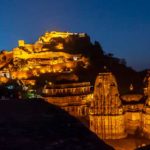Top 10 Things to Do in Chittorgarh is best known for its iconic Chittorgarh Fort, one of the largest forts in India. This massive fort stands atop a hill, overlooking the city and offering breathtaking views of the surrounding landscape. It is a UNESCO World Heritage Site and a testament to the city’s glorious past. The fort is replete with historical structures, including palaces, temples, towers, and reservoirs.
One of the most notable structures within the fort is the Rana Kumbha Palace. It was the residence of the brave Rajput ruler, Rana Kumbha, and is known for its impressive architecture and intricate carvings. The palace is now in ruins, but it still holds an aura of grandeur and is a popular tourist attraction.
Another highlight of Chittorgarh is the Padmini Palace, which is associated with the legendary Queen Padmini. The palace is known for its elegant design and reflects the Rajput architectural style. It is believed to have been the place where the Sultan of Delhi, Alauddin Khilji, saw a reflection of Queen Padmini, which led to the siege of Chittorgarh.
Chittorgarh is also home to several ancient temples that showcase the city’s religious heritage. The Meera Temple is dedicated to the mystic poet-saint Meera Bai and is visited by devotees from far and wide. The Kalika Mata Temple, dedicated to the Hindu goddess Kali, is another significant temple in Chittorgarh.
In addition to its historical and architectural wonders, Chittorgarh Tour Packages hosts vibrant festivals that celebrate its cultural traditions. The Jauhar Mela, held annually, commemorates the courageous acts of self-immolation committed by Rajput women during times of siege. The festival is a solemn tribute to their bravery and serves as a reminder of the city’s heroic past.
Chittorgarh offers a unique blend of history, culture, and architectural splendor. Exploring its forts, palaces, temples, and participating in its festivals allows visitors to immerse themselves in the glorious heritage of this city. Chittorgarh truly stands as a testament to the valor and resilience of the Rajput warriors who called it home.
Chittorgarh, located in the state of Rajasthan, India, is known for its rich history and magnificent fort. Here are the top 10 things to do in Chittorgarh:
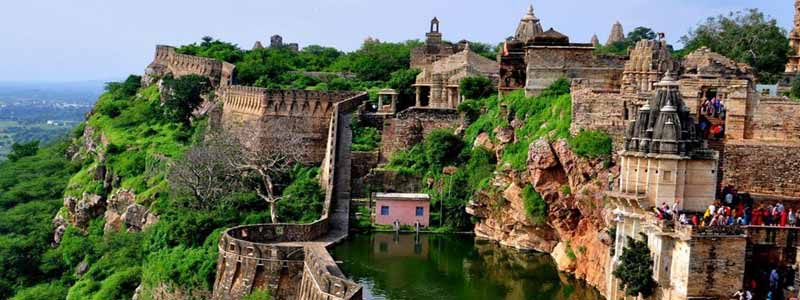
Visit Chittorgarh Fort
Chittorgarh Fort, located in the city of Chittorgarh in the state of Rajasthan, India, is a magnificent historical fortress that stands as a symbol of Rajput valor, resilience, and rich cultural heritage. It is one of the largest forts in India, spreading across an expansive area of approximately 700 acres.
The fort’s history dates back to the 7th century when it was built by the Maurya dynasty. Over the centuries, it witnessed numerous battles, sieges, and acts of heroism. Chittorgarh Fort served as the capital of the Mewar kingdom and played a crucial role in shaping the history of Rajasthan.
The fort’s strategic location atop a hill offers commanding views of the surrounding landscape. It is enclosed by massive walls that stretch over 13 kilometers and encompass various structures of historical and architectural significance.
One of the remarkable features of Chittorgarh Fort is its array of magnificent palaces. The most renowned among them is the Rana Kumbha Palace, named after Rana Kumbha, one of the illustrious rulers of Mewar. The palace showcases impressive architecture, featuring ornate pillars, intricate carvings, and spacious courtyards. Despite being in ruins, it still evokes a sense of grandeur and offers glimpses into the royal lifestyle of the bygone era.
Another notable structure within the fort is the Padmini Palace, which holds a legendary status in Rajput history. It was the residence of Queen Padmini, known for her exceptional beauty. The palace is associated with the tale of Alauddin Khilji, the Sultan of Delhi, who was captivated by Padmini’s reflection and laid siege to the fort. The palace reflects the Rajput architectural style and provides a serene ambiance.
The fort also boasts impressive towers, including the Vijay Stambh (Tower of Victory) and the Kirti Stambh (Tower of Fame). The Vijay Stambh, built to commemorate the triumph of Rana Kumbha, stands tall with its intricate carvings depicting Hindu gods, goddesses, and mythological scenes. The Kirti Stambh, dedicated to Jainism, showcases exquisite Jain sculptures and is a testament to the religious harmony prevalent during the era.
Chittorgarh Fort holds immense historical and cultural significance and has been recognized as a UNESCO World Heritage Site. It stands as a proud testament to the valor, sacrifice, and indomitable spirit of the Rajput warriors. Exploring the fort allows visitors to immerse themselves in the rich history of Rajasthan and witness the architectural marvels of the bygone era.
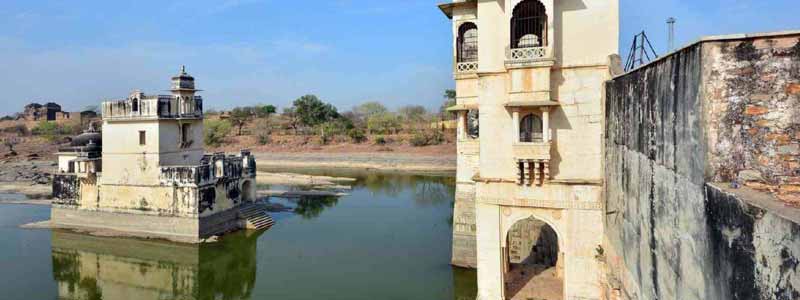
Padmini Palace
Padmini Palace, located within the Chittorgarh Fort in the city of Chittorgarh, Rajasthan, is an enchanting palace that holds great historical and cultural significance. It is named after Queen Padmini, who is renowned for her exceptional beauty and valor.
Padmini Palace is associated with a legendary tale that captures the imagination of visitors. According to the story, Alauddin Khilji, the Sultan of Delhi, heard of Queen Padmini’s mesmerizing beauty and became determined to see her. He laid siege to Chittorgarh Fort with the hope of catching a glimpse of the queen. However, Padmini, along with the other women of the palace, devised a clever plan to avoid capture.
The palace itself is a marvel of architecture and design. It is set amidst a serene lotus pond, creating a tranquil ambiance. The architecture of Padmini Palace reflects the Rajput style, characterized by delicate arches, pavilions, and balconies. The palace is adorned with exquisite carvings and beautiful frescoes that depict the tales of heroic Rajput warriors and scenes from Hindu mythology.
The highlight of Padmini Palace is the “Zanana Mahal” or the Queen’s Chamber. It is believed that here, behind a series of mirrors, the Sultan caught a glimpse of Padmini’s reflection. The clever use of mirrors allowed the queen to maintain her privacy while captivating the Sultan’s imagination.
Today, Padmini Palace stands as a testament to the beauty, grace, and valor of Queen Padmini. It offers visitors a chance to step back in time and imagine the life and legends surrounding this remarkable queen. The palace’s serene setting and intricate architecture make it a popular attraction for history enthusiasts and tourists alike.
In addition to its historical and architectural significance, Padmini Palace holds cultural and sentimental value for the people of Rajasthan. It is a symbol of Rajput pride, valor, and the enduring spirit of the people of Chittorgarh.
Visiting Padmini Palace allows travelers to immerse themselves in the rich history and captivating legends of Rajasthan. It offers a glimpse into the lives of the royalty and the remarkable women who played an integral role in the region’s heritage. Exploring the palace and its surroundings provides a deeper understanding of the rich cultural tapestry of Chittorgarh and the indomitable spirit of its people.
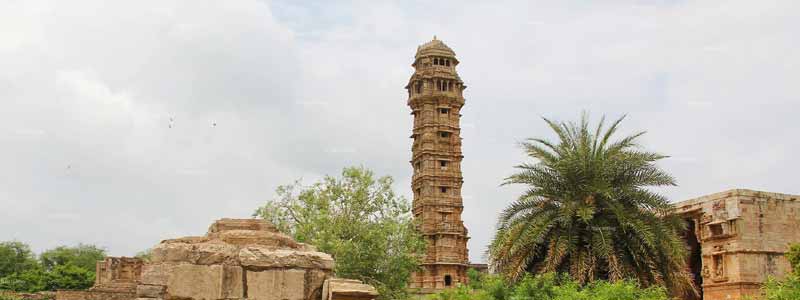
Vijay Stambh (Victory Tower)
The Vijay Stambh, also known as the Tower of Victory, is a prominent structure located within the Chittorgarh Fort in Chittorgarh, Rajasthan, India. Built by Maharana Kumbha in the 15th century, this towering monument stands as a symbol of victory, power, and the indomitable spirit of the Rajput warriors.
The Vijay Stambh was erected to commemorate Maharana Kumbha’s triumph over the Sultan of Malwa, Mahmud Khilji. It stands tall at a height of around 37 meters (122 feet) and is adorned with intricate carvings, sculptures, and inscriptions.
The tower is an exquisite example of Rajput architecture, showcasing a fusion of Hindu and Islamic design elements. It consists of nine stories, each marked by a balcony, and is built entirely of red sandstone. The intricate carvings on the exterior depict various Hindu deities, mythological scenes, and intricate motifs.
Visitors can climb the narrow staircase that winds its way to the top of the tower. From there, breathtaking panoramic views of the Chittorgarh Fort and the surrounding landscapes unfold. The tower offers a unique vantage point to appreciate the vastness of the fort and to imagine the historical battles that took place in its vicinity.
The Vijay Stambh is not only an architectural marvel but also holds cultural and historical significance. It stands as a proud testament to the valor and bravery of the Rajput warriors who defended their kingdom against foreign invaders. The tower symbolizes the resilience and spirit of the Rajputs, as well as their dedication to protecting their land and heritage.
Every year, during the Vijayadashami festival, the tower is illuminated, and cultural performances and celebrations take place in its vicinity. This festival honors the triumph of good over evil and serves as a reminder of the fortitude and courage displayed by the Rajputs throughout history.
The Vijay Stambh stands as a proud landmark within the Chittorgarh Fort, drawing visitors from far and wide who seek to witness its architectural splendor and soak in the historical legacy it represents. It is a must-visit destination for those interested in the rich history and heritage of Rajasthan.
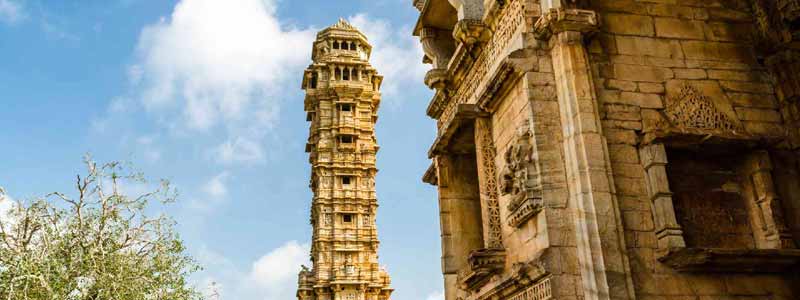
Kirti Stambh (Tower of Fame)
The Kirti Stambh, also known as the Tower of Fame, is an impressive structure located within the Chittorgarh Fort in Chittorgarh, Rajasthan, India. This towering monument stands as a tribute to Jainism and serves as a symbol of religious devotion, architectural grandeur, and cultural heritage.
Built in the 12th century by a wealthy Jain merchant named Jijaji Rathod, the Kirti Stambh is dedicated to Adinath, the first Jain Tirthankara. It stands at a height of around 22 meters (72 feet) and is adorned with intricate carvings, sculptures, and inscriptions that depict Jain deities, scenes from Jain mythology, and other religious motifs.
The tower is a fine example of the Solanki architectural style, characterized by its ornate design and intricate detailing. It is constructed entirely of white marble, which adds to its ethereal beauty and gives it a distinct presence within the fort complex.
The Kirti Stambh consists of several stories, each marked by a balcony. Visitors can climb the narrow staircase that spirals its way to the top of the tower, where panoramic views of the Chittorgarh Fort and the surrounding landscapes can be enjoyed.
The tower serves as a significant pilgrimage site for followers of Jainism. It represents the devotion and faith of the Jain community, as well as their commitment to upholding the principles of non-violence, truth, and compassion.
The Kirti Stambh stands as a beacon of spiritual and cultural significance. It is a testament to the rich Jain heritage of the region and highlights the coexistence of different religious traditions within the Chittorgarh Fort.
Visiting the Kirti Stambh provides a unique opportunity to witness the architectural splendor of Jain craftsmanship, appreciate the religious harmony prevalent in the fort’s history, and gain insights into the beliefs and practices of Jainism. It is a cherished destination for pilgrims, history enthusiasts, and those seeking to immerse themselves in the rich cultural tapestry of Rajasthan.
The Kirti Stambh stands tall, commanding attention and reverence, as a reminder of the cultural and spiritual legacy that continues to thrive in Chittorgarh. It is a captivating monument that adds to the allure and grandeur of the Chittorgarh Fort, making it a must-visit destination for anyone interested in the history and cultural heritage of Rajasthan.
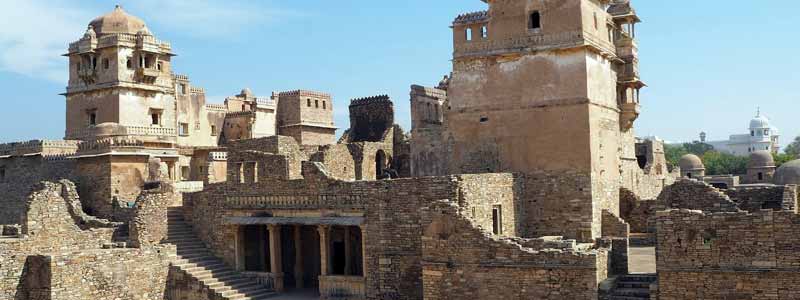
Rana Kumbha Palace
Rana Kumbha Palace, located within the Chittorgarh Fort in Chittorgarh, Rajasthan, is an architectural masterpiece that showcases the grandeur and opulence of the Rajput era. Named after the illustrious ruler Maharana Kumbha, this palace holds historical significance and offers a glimpse into the lives of the Rajput royalty.
Rana Kumbha Palace was the residence of Maharana Kumbha, one of the most celebrated rulers of Mewar. It is believed to have been constructed in the 15th century and served as the hub of royal activities and administration. The palace complex is spread across a vast area and consists of several structures, courtyards, and chambers.
The architecture of Rana Kumbha Palace is a blend of Rajput and Islamic styles. It features intricate carvings, delicate jharokhas (balconies), ornate pillars, and spacious courtyards. The palace is adorned with beautiful frescoes and murals that depict scenes from mythology, historical events, and daily life.
One of the remarkable features of the palace is the Ganesh Pol, an intricately designed gateway adorned with carvings of Lord Ganesha. It serves as the entrance to the palace complex and is a testament to the artistic skills of the craftsmen of that era.
The palace also houses the renowned Rani Padmini’s pavilion, where the queen was said to have appeared before Alauddin Khilji. This pavilion is surrounded by water bodies and offers a serene atmosphere.
Exploring Rana Kumbha Palace allows visitors to witness the grandeur and lifestyle of the Rajput rulers. The architectural brilliance, intricate detailing, and historical significance make it a captivating attraction for history enthusiasts and architecture lovers.
However, it is important to note that Rana Kumbha Palace is in ruins today. It stands as a silent witness to the battles and sieges it endured over the centuries. Despite its dilapidated state, it still exudes a sense of grandeur and serves as a reminder of the glorious past of the Rajput dynasty.
Visiting Rana Kumbha Palace provides a unique opportunity to immerse oneself in the rich history of Rajasthan and appreciate the architectural marvels of the bygone era. It allows visitors to connect with the legends and tales that surround the palace and gain insights into the cultural heritage of Chittorgarh.
Gaumukh Reservoir
The Gaumukh Reservoir is a significant water body located within the Chittorgarh Fort in Chittorgarh, Rajasthan. It is a man-made tank that holds great historical and cultural importance in the region.
The name “Gaumukh” translates to “cow’s mouth” in Hindi. The reservoir gets its name from the unique structure at its source, which resembles a cow’s mouth. Water from a natural spring flows out of a carved cow’s mouth-shaped structure, creating a serene and picturesque scene.
The Gaumukh Reservoir serves as the primary water source for the fort and its occupants. It is believed to have been constructed during the reign of Maharana Sanga, one of the prominent rulers of Mewar, in the 16th century. The reservoir has been meticulously designed with steps leading to the water’s edge, allowing people to access it easily.
The tank is not only a practical water source but also holds religious significance. Visitors can often witness devotees performing rituals and offering prayers at the Gaumukh Reservoir. The water from the tank is considered sacred and is believed to have purifying properties.
The surroundings of the reservoir offer a peaceful and tranquil ambiance, making it a popular spot for tourists to relax and soak in the serene atmosphere. The tank is surrounded by lush greenery and provides a welcome respite from the heat and hustle of the fort.
The Gaumukh Reservoir is not only a functional water body but also a place of historical and cultural significance. It adds to the charm and allure of the Chittorgarh Fort, allowing visitors to experience the architectural marvels and natural beauty that the fort complex has to offer Top 10 Things to Do in Chittorgarh.
Exploring the Gaumukh Reservoir provides an opportunity to appreciate the ingenious water management systems of the past and gain insights into the daily lives of the people residing within the fort. It is a must-visit destination for history enthusiasts, nature lovers, and those seeking a tranquil retreat amidst the grandeur of Chittorgarh.
Meera Temple
The Meera Temple, located in Chittorgarh, Rajasthan, is a renowned place of worship dedicated to the mystic poet-saint, Meera Bai. It holds immense religious and cultural significance, attracting devotees and tourists from far and wide.
Meera Bai, also known as Meera, was a 16th-century poetess and devotee of Lord Krishna. She composed numerous bhajans (devotional songs) expressing her deep love and devotion for the deity. The Meera Temple stands as a tribute to her unwavering faith and devotion.
The temple is situated within the Chittorgarh Fort, atop a hill, providing a commanding view of the surrounding landscape. It is a beautifully designed structure, adorned with intricate carvings and architectural elements that reflect the Rajput style.
The sanctum sanctorum of the Meera Temple houses an idol of Meera Bai, and the shrine is decorated with colorful paintings depicting episodes from her life and her devotion to Lord Krishna. Devotees flock to the temple to seek blessings, offer prayers, and pay homage to the legendary poet-saint.
The serene and peaceful ambiance of the temple adds to its spiritual aura. The air is filled with the melodious chanting of bhajans and the fragrance of incense. The temple courtyard provides a tranquil space for devotees to meditate and find solace in the divine presence.
Visiting the Meera Temple offers a unique opportunity to immerse oneself in the rich devotional traditions and cultural heritage of Rajasthan. It allows visitors to connect with the spiritual legacy of Meera Bai, appreciate her contributions to literature and devotion, and gain insights into the Bhakti movement that swept across the region.
The Meera Temple is not only a place of worship but also serves as a cultural center where various cultural programs and events are organized, especially during the auspicious occasions of Meera Jayanti and other festivals associated with Meera Bai.
For devotees and enthusiasts of devotional music, the temple is a haven. It hosts regular performances of bhajans and kirtans, providing a platform for musicians and singers to showcase their talent and keep the tradition of Meera’s devotional music alive Top 10 Things to Do in Chittorgarh.
The Meera Temple in Chittorgarh is a sacred place that preserves the legacy of Meera Bai and offers a spiritual experience for those who visit. It stands as a reminder of the power of devotion and serves as an inspiration for people seeking a deeper connection with the divine.
Kalika Mata Temple
The Kalika Mata Temple, situated in Chittorgarh, Rajasthan, is a revered Hindu temple dedicated to Goddess Kali. It holds great religious and historical significance and attracts devotees and tourists from all over the world.
The temple is located within the premises of the Chittorgarh Fort, atop a hill, offering breathtaking views of the surrounding landscapes. It is believed to be one of the oldest temples in Chittorgarh, with its origins dating back to the 8th century.
Kalika Mata, also known as Kali Ma, is a fierce manifestation of the Hindu goddess Durga. She is revered as the destroyer of evil and the protector of her devotees. The temple is dedicated to her worship and serves as a powerful center of spiritual energy.
The architecture of the Kalika Mata Temple is a blend of Rajput and Mughal styles. It features intricate carvings, domes, and a grand entrance adorned with detailed sculptures. The sanctum sanctorum houses the idol of Kalika Mata, with her striking depiction symbolizing her fierce form.
The temple is known for its vibrant religious festivities, especially during the Navratri festival when devotees from far and wide gather to celebrate the nine nights dedicated to Goddess Durga. The air is filled with the sounds of devotional songs and chants as devotees offer prayers and perform rituals.
Visiting the Kalika Mata Temple provides a spiritually enriching experience. The atmosphere is filled with devotion and reverence, creating an environment conducive to inner reflection and worship. Devotees seek the blessings of the goddess, praying for protection, strength, and the fulfillment of their desires.
The temple also offers a captivating glimpse into the history and culture of the region. Its location within the magnificent Chittorgarh Fort adds to its historical significance. Exploring the temple complex allows visitors to appreciate the architectural splendor and the rich cultural tapestry of Rajasthan.
The Kalika Mata Temple in Chittorgarh is a place of immense religious significance and serves as a center for spiritual connection and devotion. It stands as a reminder of the divine power and offers solace to those seeking divine blessings and guidance Top 10 Things to Do in Chittorgarh.
Bassi Wildlife Sanctuary
The Bassi Wildlife Sanctuary, located in Chittorgarh, Rajasthan, is a captivating natural sanctuary that offers a unique opportunity to explore the rich biodiversity of the region. Spread over an area of approximately 50 square kilometers, this sanctuary is a haven for nature lovers, wildlife enthusiasts, and bird watchers.
The sanctuary is situated around the Bassi Dam, which acts as a water source for the wildlife and adds to the scenic beauty of the area. The landscape is characterized by rocky hills, dense forests, and sprawling grasslands, creating a diverse habitat for a wide range of flora and fauna.
Bassi Wildlife Sanctuary is home to several species of animals, including leopards, wild boars, hyenas, foxes, jackals, and antelopes. It also provides shelter to a variety of avian species, making it a paradise for birdwatchers. Bird species such as Indian grey hornbill, white-bellied drongo, crested serpent eagle, and many more can be spotted in the sanctuary.
The sanctuary offers various activities for visitors to immerse themselves in the natural surroundings. Nature walks, jeep safaris, and birdwatching expeditions are popular ways to explore the sanctuary and observe its diverse wildlife. The tranquil ambiance and serene atmosphere make it an ideal spot for those seeking solace amidst nature.
The Bassi Wildlife Sanctuary is not just about wildlife; it also holds historical and cultural significance. The Bassi Fort, located within the sanctuary, is an ancient structure that adds a touch of history to the natural landscape. The fort offers panoramic views of the surrounding wilderness and serves as a reminder of the region’s rich past.
Conservation efforts and eco-tourism initiatives have been implemented to protect and preserve the sanctuary’s natural resources. The sanctuary plays a crucial role in maintaining the ecological balance and supporting the sustainable development of the region Top 10 Things to Do in Chittorgarh.
Visiting the Bassi Wildlife Sanctuary provides a unique opportunity to connect with nature, appreciate its beauty, and witness the diverse wildlife that thrives in the region. It offers a break from the bustling city life and allows visitors to rejuvenate their senses in the lap of nature.
Whether it’s exploring the wilderness, spotting wildlife, or simply enjoying the serenity of the surroundings, Bassi Wildlife Sanctuary promises a memorable and enriching experience for nature enthusiasts and adventure seekers alike.
Light and Sound Show
The Light and Sound Show in Chittorgarh is a captivating multimedia presentation that brings the history and legends of the Chittorgarh Fort to life. Held in the evening, the show combines the elements of light, sound, and narration to create an immersive experience for visitors Top 10 Things to Do in Chittorgarh.
The show takes place against the backdrop of the magnificent Chittorgarh Fort, which provides a stunning setting for the spectacle. The fort’s walls, towers, and palaces are illuminated with colorful lights, creating a magical ambiance.
The Light and Sound Show narrates the heroic tales, historical events, and legends associated with Chittorgarh, spanning several centuries. The powerful narration, accompanied by synchronized lighting effects and music, transports the audience back in time, enabling them to visualize the grandeur and valor of the Rajput rulers and their kingdom.
The show highlights key episodes from the fort’s history, such as the sacrifice of Padmini, the bravery of Maharana Pratap, and the battles fought within the fort’s walls. It showcases the indomitable spirit and unwavering loyalty of the Rajputs, making it a compelling experience for history enthusiasts.
The Light and Sound Show also showcases the cultural heritage of the region, presenting the rich tapestry of music, dance, and traditions that have thrived in Chittorgarh over the centuries. Folk music and performances add an authentic touch to the show, enhancing the overall experience.
Attending the Light and Sound Show in Chittorgarh offers a unique opportunity to delve into the history and legends of this magnificent fort. It allows visitors to connect with the heroic tales and cultural heritage of Rajasthan, immersing themselves in the grandeur and mystique of Chittorgarh.
The show is not only informative but also visually stunning, providing a memorable experience for individuals of all ages. It is a perfect way to conclude a day of exploration in the fort, as the captivating narrative and visual effects leave a lasting impression.
The Light and Sound Show in Chittorgarh is a must-see attraction for anyone visiting the region. It offers a fascinating journey through time, shedding light on the valor, resilience, and cultural heritage that define the spirit of Top 10 Things to Do in Chittorgarh.






